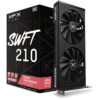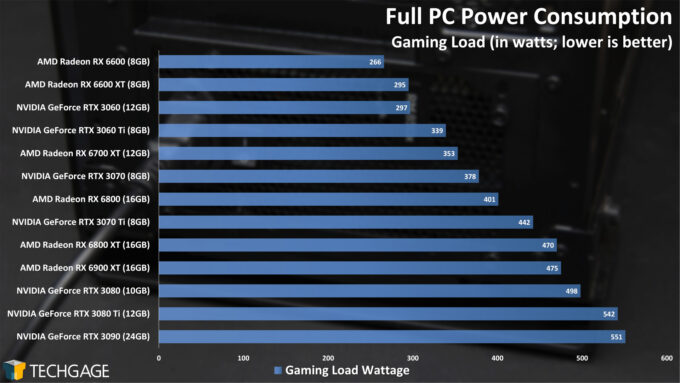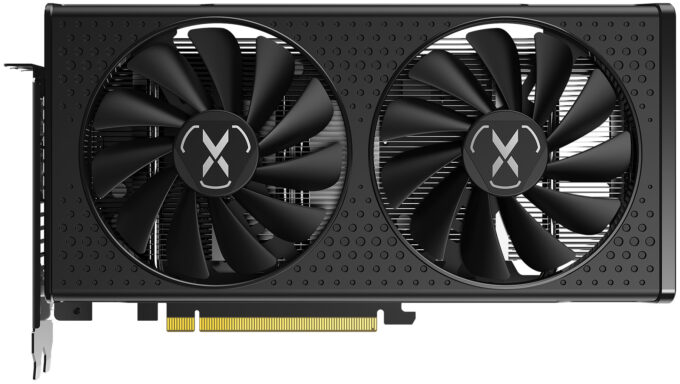- Qualcomm Launches Snapdragon 4 Gen 2 Mobile Platform
- AMD Launches Ryzen PRO 7000 Series Mobile & Desktop Platform
- Intel Launches Sleek Single-Slot Arc Pro A60 Workstation Graphics Card
- NVIDIA Announces Latest Ada Lovelace Additions: GeForce RTX 4060 Ti & RTX 4060
- Maxon Redshift With AMD Radeon GPU Rendering Support Now Available
The New RDNA2 Entry-Level GPU: AMD Radeon RX 6600 1080p Gaming Review

AMD has just launched its sixth RDNA2-based graphics card: Radeon RX 6600. At $329, this Radeon becomes the entry-point in AMD’s current-gen lineup, and does battle with NVIDIA’s GeForce RTX 3060, also priced at $329. In this review, we’re going to take a look at both cards (and more) at 1080p.
Page 3 – Power Consumption & Final Thoughts
Power Consumption
To take a look at GPUs from a power perspective, we’re using UL’s 3DMark Fire Strike 4K stress test, and the PC plugged into a Kill-A-Watt to monitor full system power draw. The PC is left to sit idle for about five minutes, or at least until the PC is idle, at which point that number is recorded. After five minutes of running the Fire Strike test, the load value is recorded (at the same point in the looped test).
It used to be that AMD’s Radeons could be expected to draw more power than NVIDIA’s GeForces in their appropriate duels, but times have changed, and RDNA2 is actually a really power-efficient architecture. Compared to the RTX 3060, AMD’s RX 6600 draws about 30W less at full load, which is nice to see. On the NVIDIA side, the GPUs include extra cores, such as Tensors and RT, which could be responsible for the additional load, even if they are not actively utilized.
Final Thoughts
We’ve said it before, and we feel compelled to say it again: this is a weird time to review graphics cards. We don’t even need to explain why, but let’s do that anyway: current graphics card pricing is generally obscene. Exceptions can be made if you are one of the lucky few who manage to find a card available in stock at a brick and mortar for SRP, or at least close to it. Otherwise, pricing on any etail website is likely going to make you question how badly you actually need an upgrade.
When NVIDIA released its RTX 3060 earlier this year, the $329 price tag was attractive – especially for a card packing 12GB of memory. In reality, though, the very second that GPU hit the market, the effective price tag was at least double. Fast-forward these eight months since that card’s launch, and the situation is unchanged. Looking at Newegg and eBay, it’s hard to find that $329 GPU for under $700.
Naturally, AMD’s new $329 Radeon RX 6600 will face the exact same fate. It actually sickens us in a way, because while a card like the RX 6600 (and NVIDIA’s RTX 3060) are solid options, their performance level doesn’t align at all with the price you will likely end up having to pay. We’re talking prices higher than the current-gen consoles for entry-level current-gen PC gaming.
That rant aside, there’s not much we can do about the current pricing; it’s just an unfortunate thing all-around, and it’s even more unfortunate that the price-gouging has already been going on for over a year.
Ignoring the current situation in the market, we can at least surmise the RX 6600’s worth against the RTX 3060 since they do carry the same projected price tag. Overall, AMD’s new card has performed very well across our chosen collection of games. While the RX 6600 ended up placing just ahead of NVIDIA’s RTX 3060 more often than not in our testing, AMD’s own, with an even larger collection, showed things more even overall. AMD has the benefit of offering similar performance at a lower power draw.
The RX 6600 is effectively an entry-level card, but it still offers good performance. We only tested 1080p resolution, but in many of our tested titles, the frame rates soared above 100 FPS. That means the card should also be more than capable of 1440p gaming across the same tested titles. That also applies to the RTX 3060.
From a special features standpoint, NVIDIA’s RTX 3060 is going to gain an edge in overall gaming if we include the use of DLSS in supported titles. Even Death Stranding, tested here, uses DLSS to good effect. Comparatively, AMD’s FidelityFX Super Resolution is a solid competitor, but its supported game count remains modest right now, as does its resultant quality vs. DLSS. DLSS will win most battles if both are compared against each other, so we look forward to seeing what future FSR iterations will bring.
If you are left with any other questions about AMD’s new GPU, please feel free to hit-up the comment section below.
Support our efforts! With ad revenue at an all-time low for written websites, we're relying more than ever on reader support to help us continue putting so much effort into this type of content. You can support us by becoming a Patron, or by using our Amazon shopping affiliate links listed through our articles. Thanks for your support!







